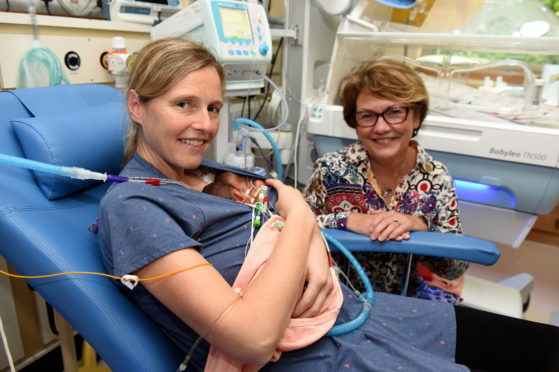An American expert in neonatal care believes a new approach she has brought to Aberdeen could save the lives of premature and critically-ill babies.
Mary Coughlin has completed a six-month course at Aberdeen Royal Infirmary (ARI) aimed at transforming care in the area.
Since its launch, 73% of staff members have been educated on its key concepts.
Ms Coughlin explained that “skin to skin care” between a parent and ailing infant can have a remarkable effect on children.
She said: “There is solid science behind skin to skin care and why it is so important.
“It is often times when the baby is at their sickest that we’ll say we’ve done everything, it doesn’t look like the baby is going to survive.
“We’ll let the parents hold the baby before he or she passes away. But the baby gets on to the skin of the parent and once they feel that, they have no intention of dying – I’ve seen this.”
Debbie Calder, 34, gave birth to baby Emilie at the neonatal unit prematurely 12 weeks ago, and she weighed 1 lb 11oz.
The mum last night praised the “skin to skin care” approach.
She said: “I think babies won’t really thrive if they haven’t got that bond and that closeness.
“We were certainly told at the beginning of the importance of skin to skin. The minute she was off the incubator, she was out.
“She’s done amazingly well and you can’t fault the staff here.”
Most neonatal units in Scotland don’t have a pain assessment tool in place to judge how babies are feeling but the team at ARI have found that this recent addition has been “vital” in ensuring that a baby’s pain is managed consistently and reliably.
Ms Coughlin added: “We actually know that painful experiences change the way their brains are wired. It changes how their bodies actually work down the road.
“In babies that have repeated pain that is not managed, or under-managed pain, there is an abnormal development of their pain pathway processes and this has been linked with medical complications down the road.”
Nurse manager, Nicola Bauwens, said: “It’s been absolutely amazing. I think a nurse hit the nail on the head yesterday when we were having a debrief.
“We said ‘what’s the feedback? What’s the initial impressions’ and she said ‘the babies don’t cry any more’. That, in a nutshell, says what we’ve achieved.
“We’ve got that education that underpins how we look after our babies, we’re not just doing what we thought was right but we’re doing what the evidence is telling us is right.”
